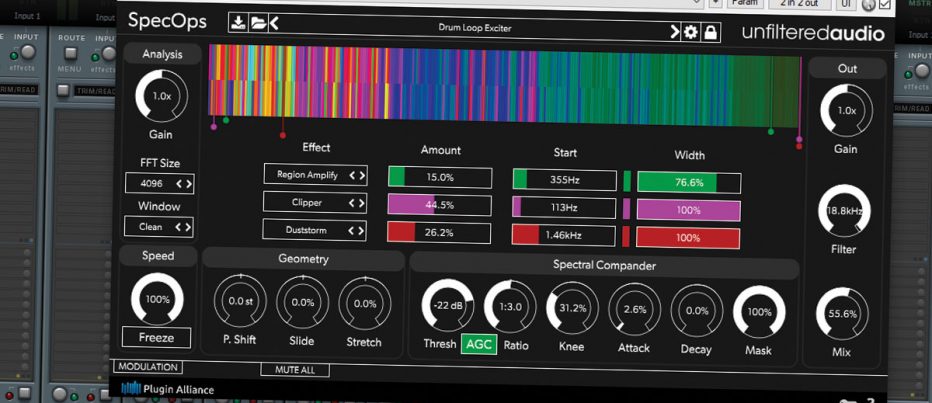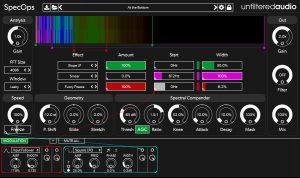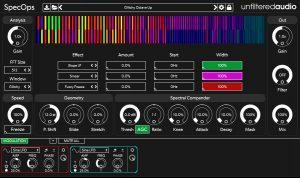Unfiltered Audio SpecOps – The Wild Child
Welcome back to Music Nation, this week we’re checking the very interesting SpecOps from Unfiltered Audio, the latest in the line of minimalistic design modular effect processors. Let’s get stuck in.
(Review updated April 2021) Ok, so this is a weird and complicated one. For a start, this is not one of your go-to, bread and butter studio basics. It’s a creative tool for inventing new soundscapes from existing audio. If you’ve any experience with FFT filters in the past then you’re a step up when looking at SpecOps for the first time. Using a similar process, SpecOps creates an FFT analysis of incoming audio and allows you to process the results using a selection of unusual tools like glitchers, freeze, Mp3ity, Duststorm and the like.
Similar in workflow and style to Unfiltered Audio’s incredible Sandman Pro delay (full review right here), you have the same basic GUI with I/O gain on the sides of the main focus work area and stackable modular units along the bottom holding your modulation blocks. Almost anything can be patched via a cable to anything, it’s a really creative and fun playground.
Now where Sandman is a delay unit, SpecOps is less descriptive as any one type of effect but could be said to be a modulation effect if you had to Pidgeon-hole it. Unlike most other modulation effects out there, SpecOps lacks any real degree of control, in that once you start fiddling and plugging bits in over here and there, you’re off on a tangent only your concentration levels (and ears) can limit.
I’m not going to dig too deep into the science behind SpecOps, it makes my eyes droop even though the manual is very well written. I think the point is NOT to understand too much and overthink it – just fire it up and get stuck in.
Road Test
Though there is a small selection of basic use presets for mixing, on the most part they are fairly humdrum and best left for other plugins that do the roles better. However, the rest of the included presets are everything from subtle to mind-blowing and really showcase the scale and flexibility of the device well.
A degree of balance is required to form new effects, you need to adjust the FFT size, window and effect amount constantly as each radically affects the other. It’s a real juggling act when you come close to something you like not to completely blow it and lose what you were working on – subtle changes the closer you get are the rule. While mostly a fairly out-there result, there’s a lot to be said for the unusual glitchy distortion you can achieve by dropping the FFT size and mucking with various geometry settings. This reminds me of granular distortion effects but in a much more gated or digital way. Applied over spoken words the results are really cool, super futuristic stuff, and something I can definitely fit into a project somewhere.
On guitar and synth lines I found a moderate degree of effect quite pleasing, but can easily get out of control if you push too hard – which may be what you’re looking for, but just to add a layer of effect that doesn’t radically alter the tone of the guitar you need to be very light-handed.
The compander section does require some discussion, as it is potentially the most effective control due to the way it boosts and expands the incoming audio signal, though again this is another control that needs to be balanced and applied subtly a little at a time else things start getting crazy very fast. The Geometry controls are brilliant and provide some insane results when you get them in the right place, I love using this on vocals, both spoken and singing.
As far as performance goes there were no issues on our test machine, even pushing the FFT to max we never noticed any spiking beyond about 5-6% per instance, so fairly well-optimised code I’m thinking in the background. Even when used last on a VSTi instrument chain, there were no serious jumps in DSP usage, so great stuff there. While the high-contrast style GUI might not be to everyone’s taste, it does grow on you and is quite easy on the eyes as you’re not peering around trying to make out switches and buttons, everything is laid out well and clearly.
Conclusion
I really dig this system and had a lot of fun playing with SpecOps, though it takes a little time to get your head around the basics, once clicked in you’ll be inventing wild and wonderful processes in no time. I look forward to seeing other applications of the platform from Unfiltered Audio and can see an excellent collective of devices over time.
At $89 USD right now it’s pretty good value, considering how flexible the unit is. Whether or not you can find $89 of value comes down to how often a device like this can find its way into a project. For me, I’m not so sure, as the really in-depth processes SpecOps is capable of being totally leftfield to the type of music I create, and to have it performing simplistic distortion and filtering seems a waste of its talents.
On the other hand, I think it’s very useful to have a device like this in your rack, even if like me you might only use it for very specific roles, its unique enough to ensure totally new and interesting results and to inspire you to explore outside the boundaries every so often, which is what any decent audio tool should do.
Full details with purchasing option on Plugin Alliances’ website www.plugin-alliance.com
Like the review? Shout us a cup of coffee!







